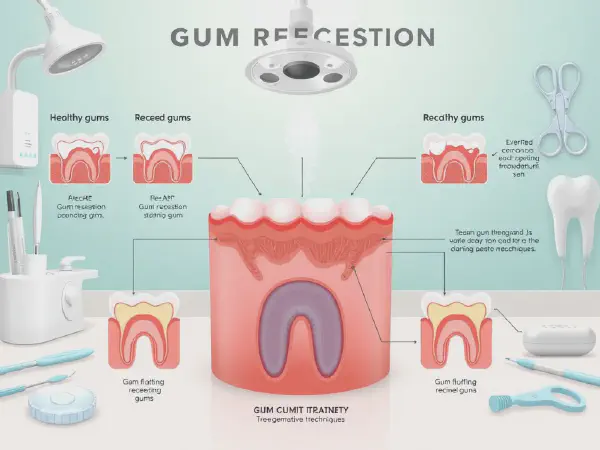Comprehensive Guide to Gum Recession Treatment: Key Insights

Gum Recession Treatment: Understanding, Options, and Recovery
Gum recession is a dental condition where the margin of the gum tissue pulls away from the teeth, exposing the roots of the teeth. This condition can lead to various dental issues, including tooth sensitivity, decay, and loss of teeth if left untreated. The treatment for gum recession aims to restore the gum tissue and provide relief from any symptoms. Understanding gum recession treatment is essential for maintaining healthy gums and preserving oral health.
There are various forms of gum recession treatment depending on the severity of the condition. These treatments may include surgical and non-surgical options or even home remedies. The choice of treatment typically depends on the extent of gum recession, the underlying causes, and the patient’s overall dental health. A thorough evaluation by a dental professional is essential to determining the most appropriate treatment plan for gum recession.
In addition to the treatments available, it is crucial to understand the importance of prevention. Implementing good oral hygiene practices, making dietary adjustments, and maintaining regular dental check-ups can significantly reduce the risk of gum recession. Patients are encouraged to consult with their dentist to develop a personalized plan for gum health to minimize the chances of experiencing gum recession in the future.
Post-treatment care and understanding the recovery process play a vital role in achieving successful outcomes from gum recession treatment. Patients need to follow their dentist's aftercare instructions closely to ensure proper healing and to avoid complications. Monitoring any signs of complications post-treatment is also essential for maintaining gum health and achieving the desired results from the treatment.
Patient experiences and testimonials provide valuable insights into the effectiveness of gum recession treatments. Many patients report significant improvements in their quality of life after undergoing treatment, including reduced sensitivity and enhanced confidence in their smiles. Before-and-after treatment photos can also illustrate the positive changes achieved through these treatments, showcasing the importance of addressing gum recession promptly.
Understanding Gum Recession
Gum recession can occur due to several factors, including periodontal disease, aggressive brushing, genetic predisposition, hormonal changes, tobacco use, and misalignment of teeth. Each of these issues can contribute to the weakening of the gum tissue, leading to recession. Understanding these causes is crucial for both prevention and effective treatment of the condition.
Symptoms of gum recession often include sensitive teeth, longer-looking teeth, visible gaps between gums and teeth, and the appearance of the roots of the teeth. Patients may also experience discomfort while brushing or flossing. Recognizing these symptoms early can lead to timely intervention and better outcomes with treatment.
If left untreated, gum recession can lead to more severe consequences, including tooth decay, periodontal disease, and even tooth loss. The exposed roots of the teeth can become vulnerable, and bacteria can accumulate in the gaps, exacerbating the problem. Understanding these potential outcomes highlights the importance of seeking treatment for gum recession early on.
Types of Gum Recession Treatments
Surgical options for gum recession often include gum graft surgery, which involves taking tissue from another part of the mouth and grafting it onto the affected area. This procedure helps restore the gum line and protect the tooth roots, minimizing sensitivity and risks of decay. Other surgical procedures may include flap surgery and pinhole surgical technique, depending on the severity and specifics of the case.
Non-surgical treatments for gum recession may involve scaling and root planing to remove plaque and tartar from below the gum line, promoting gum reattachment. Dentists may also recommend antimicrobial agents or topical treatments to reduce inflammation and promote healing. These options can be effective for less severe cases of gum recession.
Home remedies for gum recession may include saltwater rinses for anti-inflammatory properties, aloe vera for its healing benefits, and applying tea tree oil for its antibacterial effects. However, it is essential to consult a dentist before trying home remedies to ensure they will not worsen the condition.
Preventing Gum Recession
Maintaining good oral hygiene is crucial in preventing gum recession. This includes brushing twice a day with a soft-bristled toothbrush, flossing daily, and using an antibacterial mouthwash to reduce plaque buildup. Educating patients on proper brushing techniques can also prevent gum damage.
Dietary changes play a significant role in gum health. Encouraging a balanced diet rich in vitamins and minerals, particularly vitamin C and calcium, can strengthen gums and teeth. Limiting sugary and acidic foods can also help reduce the risk of gum disease and recession.
Regular dental check-ups are vital for early detection of gum recession and other oral health issues. Dentists can provide professional cleanings that remove plaque and tartar buildup and offer personalized advice for maintaining gum health. Consistent visits can prevent minor issues from escalating into more significant problems.
Recovery and Aftercare
Post-treatment care for gum recession typically involves following the dentist's instructions regarding oral hygiene practices, dietary adjustments, and any prescribed medications for pain or inflammation. Avoiding certain activities that could aggravate the treatment site is often recommended during the recovery process.
The expected recovery timeline for gum recession treatments can vary based on the specific procedure and the individual's healing capability. Generally, patients can expect some swelling and discomfort for a few days, with full recovery taking several weeks to months, depending on the nature of the treatment.
Signs of complications after treatment may include increased pain, excessive bleeding, or signs of infection such as unusual swelling or pus discharge. Patients should contact their dentist immediately if they experience any of these symptoms to address issues promptly.
Patient Experiences and Testimonials
Personal stories from patients who have undergone gum recession treatment often highlight the relief they felt post-treatment, particularly in overcoming tooth sensitivity and gaining restored confidence in their smiles. Sharing these experiences can provide hope and encouragement for those suffering from gum recession.
The impact of treatment on the quality of life can be significant. Many patients report improved comfort while chewing and speaking, as well as enhanced aesthetics of their smiles. These factors can contribute to better self-esteem and overall emotional well-being.
Before and after treatment photos can serve as powerful testimonials, illustrating the visible difference in gum health and the positive outcomes achievable through various treatment options. Many dental practices promote these stories to inspire others to seek treatment for gum recession.
